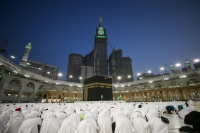
The visual icons in the cities of Makkah al-Mukarramah and Jeddah refer to the landmarks or physical features that distinguish their architectural identity. More broadly, the design of these icons can be used to signify Saudi culture in general. The most prominent ones are as follows: Makkah al-Mukarramah - The Clock Tower, located within the King Abdulaziz Endowment adjacent to the Grand Mosque in Makkah al-Mukarramah City, covers an area of 1.5 million m². The project consists of seven inter...
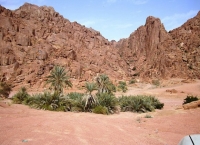
The visual icons in Hail Province are associated with the places where they are located, as architectural or natural icons. They can be used as symbols referring to the region they belong to, within Saudi culture in general, as follows: Rock drawings They are represented by the sites of Jubbah and Shuwaymis, which were included in 2015 in the UNESCO World Heritage List, making them the fourth archaeological site to be listed in the Kingdom. The Shuwaymis site contains 5,431 inscriptions in Arab...
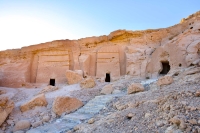
The visual icons in Tabuk Province are linked to the places located there which serve as architectural or natural symbols of the area. These icons can be used as symbols that refer to the province within the broader context of Saudi culture. Examples include: Public art icons - Tabuk City Gate Sculpture: Serving as the northern entrance to the city, it is situated in a roundabout with a diameter of two hundred m. Designed in an Islamic style, it consists of five gates symbolizing the identity a...
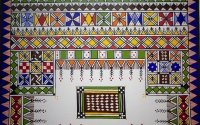
Al-Qatt al-Asiri is the art of wall decoration and ornamentation in Aseer Province in the southwestern part of the Kingdom of Saudi Arabia. The term al-Qatt linguistically means line or carving. This art form dates back hundreds of years and is closely associated with the lives of Aseeri women in the past, expressing their artistry and taste. It consists of geometric or floral patterns with bright, mixed colors, adorning walls, ceilings, and doors. Al-Qatt al-Asiri is an intangible cultural her...
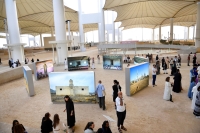
The Islamic Arts Biennale is an event organized by the Diriyah Biennale Foundation , under the supervision of the Ministry of Culture , and in collaboration with the Ministry of Transport and Logistics Services and the General Authority of Civil Aviation . It aims to celebrate Islamic culture and arts and enhance cultural and artistic exchange between the Kingdom of Saudi Arabia and the world. Held in Jeddah , the event commenced on January 23, 2023, and lasted for three months, under the theme...
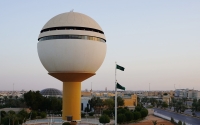
Qassim Province is located in the center of the Kingdom of Saudi Arabia, approximately 425 km northwest of the capital, Riyadh. It is bordered to the north by Hail Province, to the west by al-Madinah al-Munawwarah Province, and to the south and east by Riyadh Province. It includes various architectural, natural, and archaeological landmarks associated with the area: Urban icons: - Buraydah Water Tower: Located in the northern part of the city, it is one of the most important landmarks and an ar...
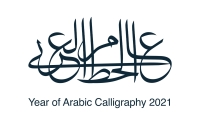
Arabic Calligraphy in the Kingdom of Saudi Arabia is one of the arts that constitutes an essential part of the Kingdom's culture, serving as a symbol of its identity. It is utilized in all daily transactions requiring the use of the Arabic language in writing or reading. The Kingdom is keen on promoting this authentic Arabic art by offering specialized awards for Arabic calligraphy. Moreover, it has established numerous centers dedicated to the preservation of Arabic calligraphy, such as t...
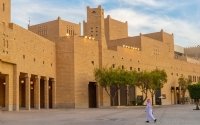
Salmani architecture is an urban style that prioritizes preserving cultural heritage while responding to modernization trends, striking a balance between tradition and modernity through urban designs inspired by Saudi heritage. The concept of Salmani architecture is closely linked to the capital of the Kingdom of Saudi Arabia, Riyadh city, which is experiencing extensive urban development in the present. It serves as a model for urban planning that serves Saudi heritage and authenticity at both...
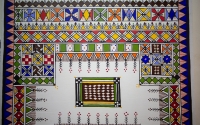
Al-Qatt al-Asiri is a traditional art form of engraving and ornamentation in the Aseer Province , southwestern Saudi Arabia . It relies on depicting geometric and floral patterns using primary colors directly on the interior walls of homes, reception areas, or any permanent and fixed surfaces. In 2017, the art of al-Qatt al-Asiri was inscribed on the Representative List of the Intangible Cultural Heritage of Humanity by the United Nations Educational, Scientific and Cultural Organization (UNESC...
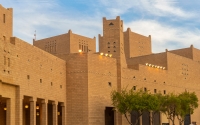
Salmani architecture is an architectural style that integrates cultural heritage with current trends. It seeks to align authenticity and modernism through urban designs inspired by the ancient Saudi heritage. The concept of Salmani architecture is directly associated with the capital city of Riyadh , which is currently expanding its scope of urbanization. The city is a model of urban planning that seeks to achieve authenticity and preserve Saudi Heritage in the short and long terms. The name ...
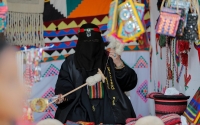
Al-Sadu traditional craft originated among Arab tribes who lived in the ancient Arabian Peninsula. Moreover, the Kingdom's handcrafting techniques helped it grow into one of the most well-known traditional arts in the Kingdom's history. It is now celebrated by the media and is a popular attraction at heritage and cultural festivals. Al-Sadu registration in UNESCO Al-Sadu is one of the Saudi heritage arts registered on the United Nations Educational, Scientific and Cultural Organizatio...

Saudi Center for Fine Art is a fine art center, established in 1985 to support fine arts by organizing exhibitions and training courses for young and adults. It offers certificates accredited by the Ministry of Culture. The headquarters is in Jeddah city. Sections of Saudi Center for Fine Art The center has a special section for women and children with a workshop devoted to children to teach them drawing. The men's section is located in the men’s gallery, with an area of one thousand m 2...